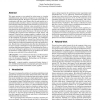Free Online Productivity Tools
i2Speak
i2Symbol
i2OCR
iTex2Img
iWeb2Print
iWeb2Shot
i2Type
iPdf2Split
iPdf2Merge
i2Bopomofo
i2Arabic
i2Style
i2Image
i2PDF
iLatex2Rtf
Sci2ools
VISUALIZATION
1998
IEEE
1998
IEEE
Building perceptual textures to visualize multidimensional datasets
This paper presents a new method for using texture to visualize multidimensional data elements arranged on an underlying threedimensional height field. We hope to use simple texture patterns in combination with other visual features like hue and intensity to increasethe numberof attribute valueswe candisplay simultaneously. Our technique builds perceptual texture elements (or pexels) to represent each data element. Attribute values encoded in the data element are usedto vary the appearanceof a correspondingpexel. Texture patterns that form when the pexels are displayed can be used to rapidly and accurately explore the dataset. Our pexels are built by controlling three separate texture dimensions: height, density, and regularity. Results from computer graphics, computer vision, and cognitive psychologyhave identified these dimensions as important for the formation of perceptual texture patterns. We conducted a set of controlled experiments to measure the effectiveness of these dimensio...
| Added | 05 Aug 2010 |
| Updated | 05 Aug 2010 |
| Type | Conference |
| Year | 1998 |
| Where | VISUALIZATION |
| Authors | Christopher G. Healey, James T. Enns |
Comments (0)

